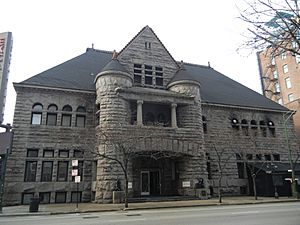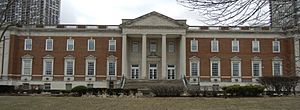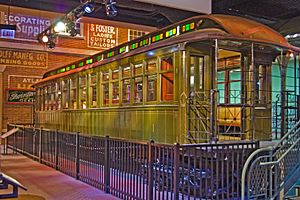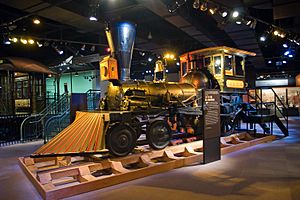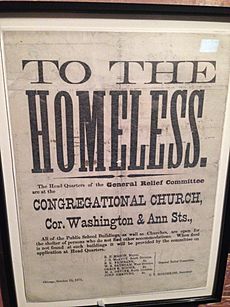Chicago History Museum facts for kids
The Chicago History Museum is the main museum of the Chicago Historical Society (CHS). The CHS started in 1856. Its goal was to study and share the story of Chicago's past. The museum has been in Lincoln Park since the 1930s. You can find it at 1601 North Clark Street. This is near North Avenue in the Old Town Triangle neighborhood. The museum has grown bigger many times over the years. For a long time, it was known as the CHS. In September 2006, the society started using the name Chicago History Museum for its public face.
Contents
The Museum's Story
Early Days and Fires
Much of the Chicago Historical Society's first collection was lost. This happened during the terrible Great Chicago Fire in 1871. But the museum, like the city, rebuilt itself. One very important item lost in the fire was Abraham Lincoln's final copy of the Emancipation Proclamation. Lincoln had given this paper to a nurse named Mary Livermore. She planned to sell it to raise money for a Civil War Soldiers' Home in Chicago.
After the fire, the Society began collecting new items. These were stored in a building owned by J. Young Scammon. He was a well-known lawyer and a member of the society. However, this building and the new collection were also destroyed by fire in 1874.
A Fireproof Home
The Chicago Historical Society then built a special fireproof building. It was on the same spot where their building stood before the 1871 fire. This new building opened in 1896. It was home to the society for 36 years. This building is now known as the Old Chicago Historical Society Building. It is listed on the National Register of Historic Places.
Growing Collections
Charles F. Gunther was a famous collector in Chicago. After he passed away in 1920, the Chicago Historical Society bought most of his collection. They paid $150,000 for it. Soon after, the society started building a new museum. This new building cost $1 million. It was made to show off their much larger collection.
The new museum opened in 1932. It is located at Clark Street and North Avenue. This is the building we know today as the Chicago History Museum. The society bought the rest of Gunther's collection in 1920. They wanted to become more than just a research place. They wanted to be a public museum.
Many items in Gunther's collection were about Abraham Lincoln and the American Civil War. These include Lincoln's deathbed. There are also other pieces of furniture from the room where he died. The collection even has clothes that Lincoln and his wife, Mary Todd Lincoln, supposedly wore. They wore these clothes on the night he was assassinated. The collection also holds the table where General Robert E. Lee signed his surrender in 1865. This act officially ended the American Civil War. It happened at the McLean House in Appomattox, Virginia.
In 2010, the museum was honored. It was added to the Chicago Gay and Lesbian Hall of Fame.
The Museum Building
Moving to Lincoln Park
After 36 years in the old building on North Dearborn Street, the museum moved. The library also moved to the current location in Lincoln Park. The oldest part of the museum was built in 1932. It was designed by Graham, Anderson, Probst & White. The WPA helped build it. The goal was to create more space for public exhibits.
Building Expansions
The 1932 building has been made bigger twice. The first addition opened in 1972. It was covered in limestone. Alfred Shaw and Associates designed it. The second addition was built in 1988. Holabird and Root designed this part. They also changed the outside of the earlier addition to red brick. This made all three parts of the building look the same.
Both new parts were added to the west side of the 1932 building. This kept the original entrance facing Lincoln Park. However, the main entrance and lobby were moved. They are now in the new western addition, facing Clark Street. The modern 1988 addition has more exhibit spaces. It also has the museum's gift shop and a public cafe.
What You Can See and Do
Exploring Chicago's Past
The museum helps visitors learn about both Chicago and American history. The exhibits mostly use items from the museum's own collection. This collection has about 22 million items!
Chicago: Crossroads of America is a huge exhibit. It covers 16,000 square feet. It shows how Chicago grew. It also explains how Chicago affected American history. Nearly 600 objects tell the stories of people and events from the last 200 years.
Facing Freedom looks at eight American struggles for freedom. These happened from the 1850s to the 1970s. The Abraham Lincoln areas highlight his election. They also show his leadership during the Civil War and his assassination. The nearby Portrait Gallery has an exhibit about Chicago during Lincoln's time.
The Sensing Chicago exhibit is great for kids. It lets them use their senses to discover the past. The main lobby shows off many of the museum's special treasures. The newly fixed dioramas are in the Tawani Foundation Diorama Hall. These dioramas show Chicago growing from a small outpost to a busy city. They also show the World's Columbian Exposition of 1893.
The Chicago Room looks out over the plaza in Lincoln Park. It has a collection of beautiful stained glass. This room can be rented for events like meetings or weddings.
Special Exhibitions and Projects
The museum also has temporary exhibits. These show items from the collection. They cover many topics. These include Chicago art, the history of LGBTQ+ Chicagoans, and the city's fashion history.
In October 2013, the museum started a special project. They asked the public for ideas for a future exhibit. Then, people voted on the most popular ideas. This helped choose one main topic for the exhibit. This was the first time an American museum used crowdsourcing to get an exhibit idea from the public.
Historic Transportation
On January 19, 2006, a very old train car arrived at the museum. This was the first passenger car to run on Chicago's 'L' train system. It started in 1893. Passengers could ride this 1893 'L' car from the Loop to Hyde Park. It cost only 5 cents to go to the World's Columbian Exposition.
This train car, called L Car #1, was carefully fixed to look like it did in 1893. Then, it was brought to the museum. Workers made an opening in a wall on the second floor to lift it inside. The car's inside has fancy mahogany wood, rattan seats, and etched glass windows.
The L car joined the Pioneer. This was the first train engine to operate in Chicago. A new exhibit space opened on September 30, 2006. It was designed to show off both the train car and the locomotive. This was part of a bigger museum update.
Research and Resources
The museum has Chicago's most important collection of local history materials. The large research library has books, papers, manuscripts, paintings, sculptures, and photos. It is open to everyone, including students working on school projects.
The costume collection is huge, with over 50,000 pieces. It includes clothes from the 1700s to today. It has many fancy designer clothes. It also has items made by famous Chicago designers. And it has clothes worn by important Chicago residents.
The museum offers many programs, books, and online tools. These help people learn about Chicago and American history. This includes the Encyclopedia of Chicago, which is available online and in print. The museum's Chicago Fire mobile app is like a 400-page book. It has over 350 pictures from the museum's collection. The app also shows 10 different Chicago areas. It highlights 54 fire-related landmarks. The app uses GPS to help you see photos of nearby places from the time of the Great Chicago Fire.
The museum also publishes Chicago History magazine. Historians write for this magazine. It has many pictures. It focuses on Chicago's interesting past and the people who shaped it. Also, over 50,000 pictures from the collection are now digital. You can find them through Explore Chicago Collections.
Every year, the Chicago History Museum honors important Chicagoans and groups. They give out "Making History Awards."
See also
 In Spanish: Museo de Historia de Chicago para niños
In Spanish: Museo de Historia de Chicago para niños
- List of museums and cultural institutions in Chicago
- List of historical societies in Illinois



